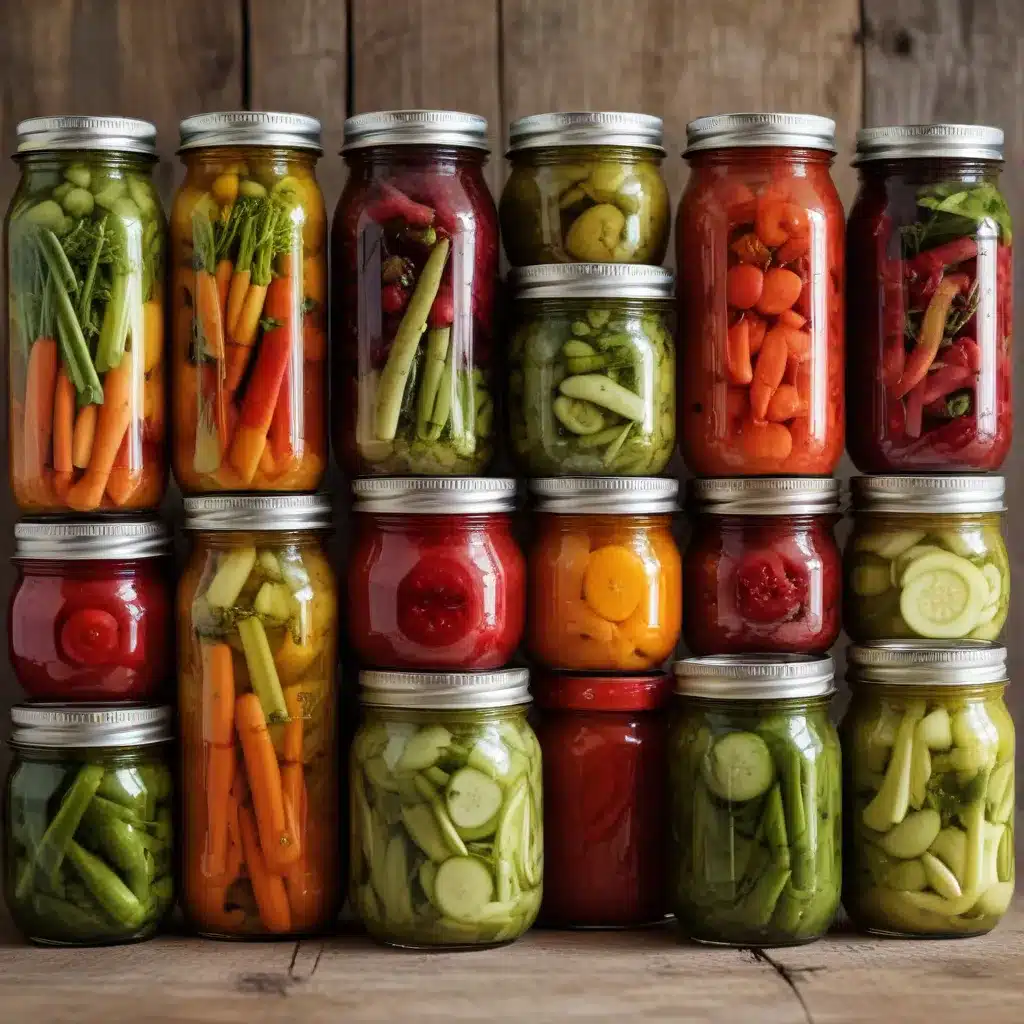
As the seasons shift and the last of the summer’s bounty is gathered from the fields and orchards, the time has come to preserve the harvest. Canning, pickling, and fermenting are age-old techniques that allow you to enjoy the flavors of the farm all year round, from crisp pickled vegetables to tangy fermented sauerkraut and shelf-stable canned tomatoes.
At Crooked Pines Farm, we believe in making the most of each season’s gifts. Whether you’re a seasoned home preserver or just starting your food preservation journey, this comprehensive guide will equip you with the knowledge and skills to safely and successfully can, pickle, and ferment your way to a well-stocked pantry.
Fundamentals of Food Preservation
Canning Techniques
Hot Water Bath Canning is the go-to method for high-acid foods like fruits, jams, and pickles. By submerging sealed jars in boiling water, you can create a vacuum seal that prevents microbial growth and allows the contents to be shelf-stable for up to a year or more.
On the other hand, Pressure Canning is required for low-acid foods such as vegetables, meats, and soups. The higher temperatures and pressures achieved in a pressure canner are necessary to kill off potentially deadly botulism bacteria. While it requires a bit more specialized equipment, pressure canning is an essential skill for the well-rounded home preserver.
Pickling Methods
Vinegar-Based Pickling utilizes an acidic brine made from vinegar, salt, and sometimes sugar to preserve vegetables. The acid environment inhibits the growth of harmful microbes, creating a crisp, flavorful pickle that can be stored for months.
Fermented Pickles, on the other hand, rely on the natural lactic acid produced by beneficial bacteria to achieve preservation. This age-old technique not only extends the shelf life of your produce but also enhances its nutritional value by introducing gut-friendly probiotics.
Fermentation Principles
Anaerobic Fermentation is the key to successful vegetable fermentation. By creating an oxygen-free environment, you allow the desired lactic acid bacteria to thrive while keeping harmful microbes at bay. This process, known as lacto-fermentation, results in the development of a tangy, complex flavor profile.
Canning Essentials
Equipment and Supplies
At the heart of any successful canning operation are the right tools for the job. Start with a reliable set of canning jars with new, undamaged lids and rings. Specialized canning tongs, a jar funnel, and a bubble remover will also come in handy.
For pressure canning, you’ll need a USDA-approved pressure canner, complete with a functioning pressure gauge that has been tested for accuracy. Water bath canners can be as simple as a large stockpot with a rack to hold the jars.
Preparation and Processing
Thorough produce selection and preparation are crucial for food safety and quality. Carefully inspect your fruits and vegetables, discarding any that are bruised, damaged, or overripe. Wash, trim, and cut the produce as directed by your recipe.
When it comes to filling and sealing the jars, maintain strict sterilization protocols. Submerge clean jars in boiling water for at least 10 minutes, and ensure lids and rings are also sanitized. Follow your recipe’s specific instructions for headspace, air bubble removal, and proper lid application.
Food Safety Considerations
Canning success hinges on understanding the importance of acidity and pH levels. High-acid foods, like tomatoes and most fruits, can be safely processed in a water bath canner. Low-acid items, such as vegetables and meats, require the higher temperatures of a pressure canner to eliminate the risk of botulism contamination.
Pickling Fundamentals
Selecting Vegetables and Seasonings
When it comes to pickling, the possibilities are endless. Classic cucumber pickles are always a hit, but don’t be afraid to experiment with a wide variety of vegetables like carrots, green beans, cauliflower, and even radishes. Mix and match aromatic herbs and spices like dill, garlic, peppercorns, and mustard seeds to create unique flavor profiles.
Brining and Acidification
The key to perfect pickles lies in the brine. For vinegar-based pickles, a combination of vinegar, salt, and sometimes sugar creates the acidic environment that inhibits microbial growth. Fermented pickles, on the other hand, rely on a salt-based brine to facilitate the lactic acid fermentation process.
Storing and Aging Pickles
Whether you opt for the quick crunch of vinegar-based pickles or the more complex flavors of fermented veggies, proper storage and aging are essential. Vinegar-pickled items can be enjoyed right away but will continue to develop their signature tang over time. Fermented pickles require a longer curing period, often several weeks, before they are ready to be transferred to cold storage for longer-term preservation.
Fermentation Overview
Biology of Fermentation
At the heart of fermentation is the activity of lactic acid bacteria, which thrive in an anaerobic (oxygen-free) environment. These beneficial microbes convert the natural sugars in vegetables into lactic acid, creating a preservative environment that enhances both flavor and nutrition.
Fermentation Vessels and Equipment
When it comes to fermenting at home, your setup can be as simple or as elaborate as you’d like. Basic fermentation vessels like mason jars, crocks, or specialized airlock-equipped containers provide the anaerobic conditions necessary for successful fermentation. Fermentation weights help keep your vegetables submerged in the brine.
Flavor Development and Nutrition
Fermented foods not only boast a unique, tangy flavor but also provide a host of health benefits. The fermentation process increases the bioavailability of vitamins and minerals, while the probiotic cultures support a healthy gut microbiome. As an added bonus, homemade fermented veggies are an economical and delicious way to enjoy the harvest all year round.
Whether you’re new to home food preservation or a seasoned pro, Crooked Pines Farm is here to guide you through the ins and outs of canning, pickling, and fermenting. By mastering these time-honored techniques, you can savor the bounty of the seasons and share the farm-fresh goodness with your family and friends. Visit www.crookedpinesfarm.com to explore more of our educational resources and join us in celebrating the art of preserving the harvest.


